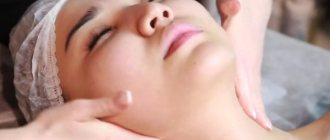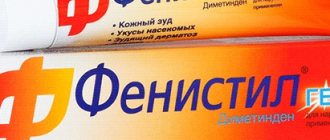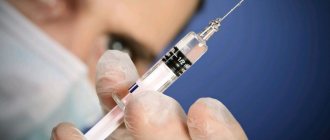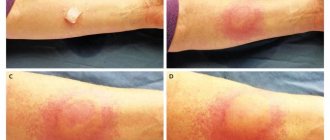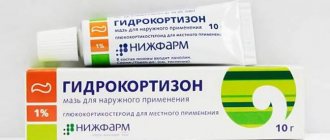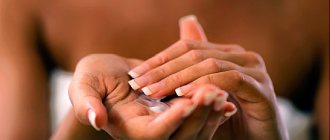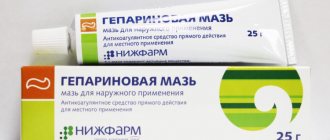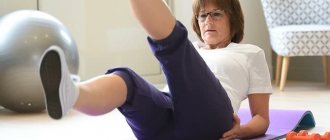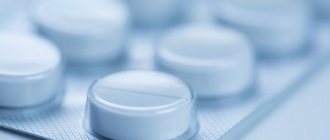Review
All ointments for allergies in adults can be divided into 2 groups - non-hormonal and hormonal. Each type has its own pros and cons that should be taken into account during therapy.
Anti-allergy ointment should be selected individually, depending on the severity of allergic manifestations and the characteristics of the skin.
Hormonal
Hormonal ointment contains corticosteroids. It has a complex effect: it stops the production of histamine, removes itching and inflammation, and relieves external signs. Hormonal ointments should not be used for a long period of time. They are most effective for severe forms of allergies, such as dermatitis or eczema.
Due to the hormone content, this type of cream should not be used in children.
Hormonal drugs:
- Hydrocortisone.
- Afloderm.
- Lorinden.
- Lokoid Lipocrem.
- Elokom.
- Elidel.
- Gistan N.
- Akriderm.
- Beloderm.
- Sinaflan.
- Flucinar.
- Dermovate.
- Triderm.
In case of extensive damage, these anti-allergenic agents are not used on the face.
Non-hormonal
Non-hormonal ointments for allergies are effective if the symptoms are mild and the disease is mild. They cope well with allergic manifestations, but the effect is noticeable 3-4 days after the start of use. The advantage of non-hormonal drugs is their safety and the absence of severe side effects. They do not affect the functioning of internal organs.
Most non-hormonal drugs are suitable for treating allergies in pregnant, lactating women and newborns.
All drugs in this group can be divided into 3 subgroups: antihistamines, anti-inflammatory, moisturizing and skin-softening ointments.
Antihistamines for facial skin allergies are one of the best non-hormonal drugs. They effectively cope with itching and redness, since they suppress the production of histamine, which provokes an allergic reaction. Good antihistamine ointments:
- Fenistil. Helps get rid of the symptoms of allergic dermatitis.
- Psilo-Balm. It is an effective remedy for swelling on the face.
Moisturizing and healing ointments do not directly affect the cause of the allergic reaction, but fight the symptoms. They are suitable for mild facial allergies. For severe allergic reactions, they are best used in combination with hormonal agents.
Effective drugs:
- Bepanten. Accelerates skin healing, suitable for pregnant women and newborns.
- D-Panthenol. Soothes and heals the skin, suitable for any type of facial allergy.
- La Cree. Heals damage and relieves irritation. Effective for atopic dermatitis.
- Nezulin. Cream-gel eliminates irritation, redness and itching. It is a natural remedy and therefore has no side effects.
- We see. Restores damaged skin.
- Radevit Active. Increases the regenerative function of the epidermis.
In case of severe redness and swelling, anti-inflammatory drugs should be used. Ointment for allergies on the face, which has an anti-inflammatory effect:
- Gel Nise. Soothes, relieves itching and pain.
- Salicylic ointment. Effective for allergic rashes that are accompanied by inflammation of the skin. The course of treatment is no more than 21 days.
- Skin Cap. This is an expensive but effective remedy that does not cause side effects. The course of treatment is 1 month. Before applying the product, you need to treat the skin with an antiseptic.
- Indovazin gel. It has a pronounced analgesic effect, eliminates redness and swelling. Can be used for no more than 10 days.
- Radevit. Relieves inflammation, eliminates itching, increases the protective function of the skin.
- Zinc ointment. Particularly effective for weeping wounds. Has a drying effect.
One of the best remedies is Skin-Cap. It is effective for seborrheic and atopic dermatitis, eczema and psoriasis.
Ointments by type of allergy
Antiallergic ointment should be selected not only based on the severity of allergic manifestations, but also depending on the type of allergy.
List of effective remedies:
- allergy to the sun - Solcoseryl, Videstim, Radevit and Actovegin;
- allergic reaction on the face to cold - Elokom, Levomekol, Levosin;
- food allergies – Advantan, Lorindens S, Diaderm, Dermovate, Zinc ointment, Sinaflan;
- allergic reaction to cosmetics - Kremgen, Elidel, Advantan;
- atopic dermatitis – Dermovate, Skin-Cap, Celestoderm B;
- eczema – Advantan, Hydrocortisone ointment, Skin-Cap.
For pregnant women, nursing mothers and children, it is worth choosing the safest products. These are Fenistil, Psilo-Balm, Zinc ointment. Hormonal drugs are prohibited.
If the allergy is accompanied by severe inflammation, suppuration and crusting, antibacterial agents should be used, for example:
- Levomekol.
- Erythromycin ointment.
- Fucidin.
Drugs in this group are used only as part of complex therapy.
In case of a fungal infection, you cannot do without Miconazole, Clotrimazole, Lamisil.
Reviews
During the off-season, I often suffer from atopic dermatitis. Previously, I was saved by cheap Sinaflan and Hydrocortisone ointment. But recently the dermatitis was complicated by a bacterial infection, so the doctor prescribed Triderm. Its price is quite high, but it copes with its task with five plus.
I will leave my positive review about Gistan with a pleasant floral scent. After applying it, the rashes become smaller, they turn pale and decrease in size. The ointment perfectly moisturizes and nourishes the skin, heals minor damage.
What is better - cream or ointment?
To treat allergic rashes on the face, you can use ointments, creams and gels. But which release form is better? To understand, you should know the advantages and disadvantages of each.
All forms of release relieve allergy symptoms on the skin of the face - redness, rash, itching and dryness. The ointment has a heavier fatty structure, but it has a rich biologically active composition, and accordingly, it has a powerful effect. Thanks to its oily consistency, it penetrates into the deep layers of the epidermis. A significant disadvantage is slow absorption.
Skin allergy cream has a faster effect. Thanks to its light texture, it is absorbed into the skin immediately after application. The allergy cream on the face penetrates into hard-to-reach places, leaves no trace, and can be used on large affected areas. Most effective for dry skin.
The gel does not clog pores, unlike ointment. It is quickly absorbed into the skin, acts instantly and leaves no trace. Anti-allergenic cosmetics in gel form should be used for atopic dermatitis, allergies to insect bites, sun or cold.
Possible side effects
Almost any drug can cause a number of side effects.
The development of undesirable reactions when using hormonal external agents in most cases is explained by incorrect selection of the dose and type of drug by the patient himself.
More undesirable changes can be caused by hormonal drugs of high activity classes.
If the course of using hormonal drugs is short, then most often no adverse reactions develop.
Prolonged use leads to suppression of local immunity, and this can affect the addition of a secondary infection.
POPULAR WITH READERS: A medical mask causes allergies. What to do?
To prevent such phenomena, allergists select a combination remedy for their patients, which, in addition to the hormone, also includes an antifungal component or antibiotic.
Under the influence of hormones in the skin, collagen production decreases, and this can provoke dryness and the development of atrophic changes.
This happens especially often when using hormonal drugs on the face and groin folds.
If the dose is exceeded, there is a possibility that some of the hormones will enter the general bloodstream, which affects the appearance of systemic changes.
The group of possible complications when using external steroid drugs includes:
- The appearance of acne.
- Increased skin dryness.
- Perioral dermatitis.
- Folliculitis.
- Symptomatic hypertrichosis.
- Activation of mycosis, that is, a fungal infection.
- The appearance of erythema, telangiectasia.
- In rare cases, Cushing's syndrome develops.
- The appearance of pigmented spots on the skin.
Hormonal ointments are not applied to the area near the eyes and especially to the eyelid. If this rule is neglected, it is possible to provoke the appearance of glaucoma or cataracts.
When a corticosteroid drug is discontinued, all side effects usually disappear over time.
Complete removal of steroids accumulated in the skin and inside the body takes from two weeks to six months.
Contraindications
Allergy treatment should be supervised by a dermatologist or allergist. You should not self-medicate, especially with hormonal ointments.
Contraindications to the use of antiallergic topical agents are:
- fungal, bacterial or viral damage to the skin;
- acne (acne);
- scabies;
- chicken pox;
- individual intolerance to the components in the composition.
Each product also has age restrictions. When using in children, you should read the instructions.
In case of parasites, viruses or fungi, ointments contribute to the spread of pathogenic microflora over large areas.
Hormonal creams are also not used during pregnancy and lactation.
Allergy ointment is an effective form of release. But even the most powerful antiallergic local remedy will not relieve allergic manifestations unless the effect of the allergen is stopped.
Author: Oksana Belokur, doctor, especially for Dermatologiya.pro
Special instructions for use
All instructions regarding the use of hormonal agents must be strictly followed.
When using ointments with steroids, you must follow the following rules:
- Be sure to maintain good hygiene.
- Thoroughly moisturize the skin. After a course of using corticosteroid ointments and creams, it is necessary to select an ointment that will enhance hydration and nutrition of the skin.
- Buy only the ointment prescribed by the doctor.
- Before first use, perform a sensitivity test. To do this, apply a small amount of the product to the wrist and after 15 minutes the condition of the skin is assessed.
- If no negative changes are recorded, then the prescribed drug can be safely used.
Increased itching, redness, and irritation after applying a steroid indicates an individual intolerance to the components of the drug.
The product should be washed off the skin and, after consulting a doctor, choose another medication.
Rules for using ointment for skin allergies
We will tell you below how to get rid of allergies. First, let's look at the rules that must be followed strictly.
1. Non-hormonal drugs will not give results in severe forms of the disease. In turn, hormonal drugs cannot be used for a long time without consulting a doctor.
2. Observe the frequency of use. Do not mistakenly believe that frequent application will lead you to positive dynamics. On the contrary, abuse of the drug provokes swelling and other problems.
3. During treatment, try not to touch healthy areas of the skin. Apply the ointment locally by gently tapping or rubbing. Otherwise, the skin that is not affected by allergies will become red and swollen.
4. Hormonal ointment is used for severe allergies. If skin rashes in adults are minor, then it is better to give preference to non-hormonal formulations.
5. External medications cannot be considered harmless; study the package insert and follow the instructions. Pay special attention to the section with contraindications.
6. Hormonal drugs are used for a certain course, no longer. The active substances of such drugs penetrate the bloodstream, negatively affecting the endocrine system.
7. A severe form of the reaction is treated comprehensively; it is unlikely that positive dynamics will be achieved with ointments alone. It is necessary to take medications to suppress the root cause from the inside.
Methods of application
The duration of use, frequency of use of ointments and their dosage must be explained to the patient by the doctor.
When prescribing a drug, the severity of the inflammatory process, the general well-being of the patient are taken into account, and it is also determined whether the preliminary treatment was with systemic or local drugs.
A qualified allergist initially selects a drug that, along with being highly effective, has the greatest safety in relation to the general health of a person.
Hormonal products that do not contain fluoride are considered the safest in this regard.
Non-hormonal ointments for skin allergies
Treatment of allergies with drugs without hormone-like substances can quickly eliminate hives on the skin. Treat affected areas by gently rubbing. Soon the allergic process will begin to subside.
No. 1. Bepanten
Price – from 500 rubles. The active ingredient is dexpanthenol, which has regenerating and soothing properties. The ointment is used for skin allergies not only in adults, but also in the younger generation. The product penetrates into the lower layers of the dermis, eliminating redness. As an alternative, it makes sense to take a closer look at analogues: “Dexpanthenol”, “Panthenol”, “D-Panthenol”.
No. 2. Fenistil
Price – 450 rubles. "Fenistil" is a gel with antihistamine activity, which is why it is so effective in relieving allergies. The drug concentrates dimethindene maleate, which is aimed at suppressing itching, redness, severe swelling, and pain. After treating the affected areas, the result appears after half an hour.
No. 3. Solcoseryl
Price – 500 rubles. Available in various forms, including ointment and gel. The basis is a concentrate obtained by special processing of calf blood. The product has a powerful wound-healing effect, so it is used for burns with boiling water. However, the ointment can also be used for skin allergies in adults. The negative reaction disappears 40 minutes after treatment.
No. 4. La Cree
Price – 280 rubles. The cream has a gentle effect on the skin, relieving severe irritation, itching, and redness. The drug restores tissue integrity at the cellular level and concentrates panthenol as an active substance. Suitable for persons with overly sensitive skin.
No. 5. Protopik
Price – 650 rubles. Anti-inflammatory ointment, an antidepressant for allergies, is often used to treat the skin on the face. Experts also prescribe it for atopic dermatitis in adults. The antihistamine drug concentrates tacrolimus. The main compound softens and regenerates the skin, eliminates unbearable itching.
No. 6. Methyluracil
Price – 80 rubles. A cheap product designed to accelerate tissue restoration at the cellular level. In addition to its main purpose, the ointment relieves allergies, relieves itching on the skin in adults, and increases the skin's resistance to allergens by strengthening local immunity.
No. 7. Gistan
Price – 200 rubles. Non-hormonal cream includes herbal substances with antihistamine properties. Among analogues, the cosmetic product is considered the safest. Thanks to oils, butelin, dimethicone, and other natural extracts, the skin quickly calms and restores. The product is developed not only for allergies, but also for other skin rashes.
No. 8. Skin Cap
Price – from 900 rubles. Cream for external use, including zinc pyrithione as a base. It is used for severe allergic reactions that are accompanied by blisters, itching, redness and pain. The medicine has antiseptic and wound-healing activity, so it is worth keeping it in your medicine cabinet.
Hormonal ointments for skin allergies
Any ointment containing hormones will help get rid of severe allergies, which are accompanied by severe swelling, itching, and redness. To eliminate unpleasant symptoms on the skin in adults, you need to use a potent remedy.
No. 1. Advantan
Price – 650 rubles. The ointment, thick in consistency, contains the active ingredient in the form of methylprednisolone aceponate. After application, the composition almost immediately eliminates all allergy symptoms. Itching, swelling, and inflammation go away. The product is completely safe and has no side effects.
No. 2. Gistan N
Price – 170 rubles. Allergy cream is developed on the basis of mometasone. It eliminates various types of dermatoses on the skin of adults. To relieve the symptoms of an allergic reaction, the drug should be applied in a thin layer. One distribution per day is enough. The composition is recommended to be used for a course of 1 to 4 weeks.
No. 3. Elokom
Price – 80 rubles. The base contains the active ingredient in the form of mometasone fuorate. After use, the drug instantly eliminates swelling, itching, and redness. The product is effective for all types of dermatoses. The ointment is also used to treat psoriasis, eczema, and dermatitis.
No. 4. Lokoid
Price – 290 rubles. The active component is hydrocortisone 17-butyrate. The cream is highly effective for neurodermatitis, dermatitis, and eczema. To cope with an allergic reaction, the drug must be applied to problem areas. The advantage of the product is that it is quickly absorbed.
No. 5. Hydrocortisone ointment
Price – 40 rubles. The ointment relieves allergies of any nature that have formed on the skin of adults. It is very cheap and quickly eliminates redness, itching, and irritation. The product is safe and is used in ophthalmology. The drug has a powerful anti-allergic and anti-inflammatory effect.
No. 6. Sinaflan
Price – 60 rubles. The product for external use is based on fluocinolone acetonyl. The drug is famous for its pronounced antipruritic, antihistamine and anti-inflammatory properties. The ointment is prescribed for allergic diseases. The composition also helps cope with sunburn and insect bites.
No. 7. Flucinar
Price – 130 rubles. The combined ointment has a strong anti-inflammatory effect. The active substances are neomycin and fluocinolone. After applying the product, all symptoms will disappear. It is recommended to use the drug as needed.
Before treating an allergy that has occurred on the skin of an adult, try to find out the cause of its manifestation. Use all products according to instructions. If you are unsure which medication is needed, consult a dermatologist.
What are antiallergic drugs made of?
In addition to cosmetic compositions, medicinal creams must include antihistamine components. It is this substance that provides the skin with temporary protection from allergies. In order for the drug to have maximum effect, when choosing it, you need to pay special attention to the composition. A certified drug may contain the following components:
- Corticosteroids (targeted hormonal drugs);
- Antiseptic and anti-inflammatory substances;
- Moisturizing oils and herbal extracts (chamomile, oak bark, celandine, calendula);
- Panthenol (healing drug based on pantothenic acid);
- Vitamin complex;
- Glycerol.
If, when reading the composition, you encounter unknown components, then it is better not to use such a cream, since additional additives may reveal themselves in unexpected ways. If the choice of a medicinal cream is made without a doctor’s prescription, then in this case you need to read the composition and label with the utmost care, especially if you choose a hormonal drug.
Pros and cons of non-hormonal ointments
The choice of a specific drug is based on the severity of the condition, the severity of the symptoms, their number and the stage of the allergy. Non-hormonal drugs in the form of ointments are prescribed for mild symptoms. Compared to hormonal drugs (corticosteroids), they have a milder effect, and the likelihood of possible side effects is minimized.
Advantages:
- the effect on the damaged area of the body begins immediately after application;
- promote healing and regeneration;
- can be used for a long time;
- fairly harmless;
- in consultation with a doctor, some of them can be used by children and pregnant women;
- have antipruritic effects;
- most drugs are harmless;
- relapse prevention;
- some agents additionally have an antibacterial effect;
- relieve symptoms of mild forms of the disease.
Flaws:
- the effect of exposure begins to appear only an hour or two after application;
- in rare cases there may be individual intolerance;
- are not effective in late and middle stages of the disease and in severe forms.
Classification and indications for the use of antiallergic ointments
There are two types of antiallergic ointments in the pharmacy assortment - non-hormonal and hormonal. The latter contain glucocorticosteroids, which are synthetic analogues of adrenal hormones. They relieve inflammation well, relieve swelling and itching. But hormonal drugs have a significant drawback - a huge list of potential side effects.
Non-hormonal drugs are not as effective. But their beneficial properties are quite enough to eliminate allergy symptoms of 1-2 degrees of severity. Most of them are quite safe due to the mild, gentle effects of the components.
The means used depending on the location
Various products are used to treat allergies in different areas of the skin. Some of them can even be used on particularly sensitive areas, such as near the eyes.
On the face
Sensitive and fairly thin facial skin requires a careful approach to treatment. Mostly non-hormonal agents are indicated for therapy:
- Fenistil (can be prescribed to children from the age of two);
- Psilo-balm.
For centuries
For use near the eyes (on the skin of the eyelids), products are indicated that help relieve redness and do not leave a greasy film:
Such preparations are used in a thin layer once a day on the surface of the lower and upper eyelids. Application is carried out with light movements without intense rubbing.
On the legs and arms
For these areas of the body the following are often prescribed:
These drugs are well distributed, quickly absorbed and quite effective.
Ointments for skin allergies
There are cases when an allergic reaction on the skin develops quickly. This can happen as a result of an insect bite or contact with a plant. In such a situation, quick response means are used, for example, Fenistil or Psilo-balm.
Psilo-balm
This product is intended for local use for the following indications:
- burning and hyperemia after insect bites;
- chicken pox;
- cholestasis;
- itchy eczema;
- contact dermatitis;
- sun and other burns.
Apply a thin layer of gel to the skin up to four times a day and rub in lightly. It has a slight cooling and anesthetic effect. You should avoid getting the medicine on the surface of the mucous membranes, and wash your hands thoroughly after use. The duration of use is determined individually.
Price: about 250 rubles.
Soventol
The drug is packaged in tubes that can be stored at room temperature. The softening and regenerating effect allows it to be used not only for allergic reactions, but also for:
- minor thermal burns;
- sunburn;
- frostbite;
- hives;
- dermatoses;
- hay fever;
- jellyfish burns, etc.
Apply Soventol externally in a thin layer. The drug is well absorbed; if necessary, application can be repeated after half an hour. Has the property of eliminating puffiness.
Price of the drug: from 2,300 rubles.
Fenistil
This is an effective remedy for external use, which has the following indications:
- insect bites;
- hives;
- eczema;
- dermatoses accompanied by itching, etc.
To achieve a therapeutic effect, it is enough to apply the gel 2 to 4 times a day to the affected areas. In extremely rare cases, a burning sensation, itching or rash may be felt.
Price for the drug: about 400 rubles.
Salicylic ointment
This remedy can be used as a primary treatment for the following conditions:
- eczema;
- psoriasis;
- burns;
- infectious and inflammatory lesions of the skin;
- acne;
- pityriasis versicolor;
- corns and calluses;
- warts, etc.
The ointment is applied externally and has an antiseptic and anti-inflammatory effect. The drug is available in various dosages, the percentage of the active substance can range from 1 to 5. When prescribing, they are guided by the principle: a larger percentage of the active substance is taken when the symptoms of the disease are the weakest, and a smaller percentage when they are significant.
The ointment is applied 1-2 times a day in an even layer. The duration of treatment is determined by the patient’s condition and can reach 4 weeks if necessary.
Price of the drug: from 25 rubles.
Zinc ointment
This remedy is affordable and popular, as it has a low price and is practically free of side effects. Indications include:
- diaper rash;
- haemorrhoids;
- dermatitis;
- lichen;
- chicken pox;
- eczema, etc.
Apply the ointment to damaged areas of the skin until recovery 2 or 3 times a day. The safety of the composition allows the ointment to be used even in newborns. Has a drying and adsorbing effect.
Price: from 29 rubles.
Levomekol
This ointment has a combined composition that allows it to effectively act in the following conditions:
- burns (up to 3rd degree);
- boils;
- trophic ulcers;
- eczema;
- calluses;
- allergic reactions
The drug has a pronounced anti-inflammatory and antimicrobial effect. Can be used in the form of applications using gauze napkins. Application: Apply a thin layer to the surface of the skin. Use according to indications.
Price: from 108 rubles.
Protopik
The product is used externally for dermatitis and vitiligo and has an anti-inflammatory effect. The usual dosage is 1 or 2 times a day. The ointment is available in children's dosage - with a content of 0.03% and for adults - 0.1%.
Price – from 600 rubles.
Elidel
This remedy is indicated for the following diseases:
It is recommended to start using Elidel from the first symptoms 2 times a day. Can be used on the face and genital area as an independent treatment. Has anti-inflammatory effect.
Price – from 900 rubles.
ethnoscience
Traditional medicine is no less effective in treating allergies. You can also prepare an ointment from simple products at home. Here are some popular recipes:
- Mint face mask. Take 30 ml of warm water, pour 2 tbsp. dried mint, boil the mixture. After cooling, apply to the skin, rinse after 15 minutes.
- Anti-allergy ointment made from peach pits. You will need about 100 g of them. The seeds need to be split into a powder, then add 100 g of butter. Apply the resulting mixture to the affected area.
- Herbal infusion. Take nettle, celandine, chamomile, string, valerian and St. John's wort in equal proportions. Pour 1 tbsp. the resulting mixture 10 tbsp. hot water. Leave for about an hour, then wipe the problem areas with the broth up to 3 times a day.
Means to accelerate healing
Healing boosters hydrate the skin and promote better healing. For this purpose, preparations based on natural ingredients, plant extracts and panthenol are used.
Among the most effective:
- products with panthenol;
- Boro Plus;
- Mustela;
- La Cree;
- external means with a series;
- Actovegin.
Separate mention should be made of Bepanten, which is effective and can be used during pregnancy and for diaper rash in children. The ointment has a healing effect. Apply a thin layer twice a day and rub in lightly. The cost of Bepanten is from 360 rubles.
Skin allergies in adults in the form of rashes, itching and blisters can lead, if left untreated, to serious consequences, including Quincke's edema. To prevent the situation from worsening, well-chosen treatment must be carried out, during which non-hormonal external agents are often used.
Features of application
During treatment with hormonal ointments, it is necessary to take into account all the doctor’s recommendations given when prescribing the drug.
You should not increase the dosage or frequency of application on your own, even if you do not see results.
It is necessary for pregnant women and parents who treat their children with GCS to strictly adhere to the recommendations.
Features of the use of ointments for children.
Children are more likely to develop systemic side effects when using external hormonal products compared to adults.
This is explained by the anatomical features of the skin; in children it is thin, the subcutaneous tissue is poorly developed, so it is possible that hormones enter the general bloodstream.
To reduce this possibility, you must follow the following rules:
- Use only the ointment prescribed by your doctor.
- Mix the ointment with baby cream in a 1:1 ratio.
- The product cannot be rubbed into the skin, it can only be distributed in a thin layer.
- External steroids should not be used in the treatment of children for more than one month. Ideally, after a week of therapy, it is necessary to assess the condition of the skin and, if possible, switch to follow-up treatment with non-hormonal ointments.
Most often, children are prescribed ointments such as Advantan, Afloderm, and hydrocortisone ointment.
Features of the use of ointments during pregnancy.
The occurrence of allergic manifestations on the skin during pregnancy is not uncommon.
Treatment of itching, rash, and redness is mandatory, since the lack of therapy can lead to secondary infection and significantly affects the general well-being of the pregnant woman. And this negatively affects the development of the fetus.
Hormonal external agents are prescribed to pregnant women if there is no effect from other agents used.
Modern ointments practically do not penetrate into the bloodstream and breast milk, so they can be used both during pregnancy and throughout breastfeeding.
Naturally, the doctor selects products with the least hormonal activity, such as Elokom, Advantan, Dermatop, Lokoid.
For allergies to the sun.
Sun allergy or photodermatosis can occur with minimal changes on the skin or with the development of a severe skin reaction.
Hormonal ointments are prescribed by a doctor, since some of them, on the contrary, can increase photosensitivity.
Ointment against allergies on the face
It can take a long time to consider the causes of allergies on the face - traditionally, the main reasons for its occurrence are considered to be poor diet, frequent nervous stress and weakened immunity. Any manifestations of allergies cause unpleasant symptoms and also bring psychological discomfort due to a changed appearance. There are a huge number of ointments against allergies on the face, each of them can be either effective or useless. The main thing is to select them correctly and distinguish them. The most popular are Hydrocortisone and Prednisolone ointments; they are universal and suitable for all cases. Although there are many others, let’s look at each group separately.
Hormonal
The most effective ointments for facial allergies in adults are considered to be hormonal (glucocorticoids). In the shortest possible time, they eliminate the signs of allergies, even in severe forms, putting them into remission. If you need to quickly solve a problem, for example, there is an important event ahead, then hormonal ointments are ideal. Their components actively act, destroying cells that provoke inflammation on the skin, affecting the allergy itself.
However, this group of drugs has an important distinctive feature - the components of the cream penetrate not only under the skin, but also into the blood, and therefore can cause irreversible processes throughout the body. Therefore, it is important to consult with your doctor about the need to use hormonal ointments. If you have chronic diseases, your doctor may prohibit their use.
“Fenkarol”, “Prednisolone”, “Elocom”, “Advantan” are well-known ointments that are part of this group. They are usually prescribed for severe allergic reactions when other drugs have not had the desired effect. In addition, it is not recommended to use them if the patient suffers from:
- high blood pressure;
- all types of infectious diseases;
- helminthiases.
And even if a hormonal cream is prescribed by a doctor, you should remember that its long-term use is unacceptable.
Hydrocortisone
The main component of this ointment is hydrocortisone. This is a synthetic drug that perfectly relieves inflammation and its manifestations; it does not cause side effects, so it can be safely used by all categories of patients.
The cream must be applied in a thin layer over the entire surface of the irritated skin area, several times a day. The duration of therapy depends on the severity of the allergy, in some cases it can reach 3 weeks. But generally the process of getting rid of it takes about a week, sometimes two.
If after 7 days of use no improvement is noticeable, and the condition begins to worsen, then use of the ointment should be stopped. Additional treatment with drugs against fungus and bacteria is possible.
There are also contraindications:
- individual intolerance to ointment components;
- if skin lesions are caused by viruses, fungi and tumors;
- there are wounds and ulcers;
- during pregnancy and lactation.
You can understand that the body does not accept the cream by the following signs:
- swelling that occurs;
- a new wave of redness;
- itching that did not exist before use;
- secondary wave of rash;
- hypertrichosis (suppression of the adrenal cortex, which is observed in rare cases).
In general, the successful long-term use of hydrocortisone ointment suggests that it is a fairly safe drug that is highly effective.
Prednisolone
This ointment for allergies on the face is an analogue of the previous one, therefore it is also considered effective. Its use provides quick relief from itching, flaking and other inflammatory processes. The cream is quickly absorbed, and its effect begins within 15-20 minutes. It is also applied to the skin of the face several times a day for 1-3 weeks, depending on the stage of the disease. Consultation with a doctor before starting use is required.
Elokom
This is another popular allergy cream related to hormonal drugs. Its peculiarity is to stimulate the formation of its own proteins, which should block the release of elements that provoke inflammation.
Due to the strong effect on the body, consultation with your doctor is required. Just like all steroid ointments, Elokom is persistently addictive, so it is better not to use it for a long time. All possible side effects are in most cases caused by abuse or misuse of the drug.
Algorithm for the use of topical hormonal agents
Despite the least toxic effect of modern external hormonal agents, they still belong to a group of drugs with the possible development of a number of complications.
Therefore, when using creams, ointments and emulsions with hormones, you must always adhere to the following rules:
- The use of topical corticosteroids should be justified. That is, they are prescribed by a doctor after examining the patient’s skin and after conducting diagnostic procedures.
- Corticosteroid ointments are used only for treatment and cannot be prescribed for prophylactic purposes.
- The form of the drug and its dosage are selected based on the location of skin changes and the degree of damage.
- When choosing a drug, preference should be given to drugs with a prolonged effect.
- GCS can be applied to no more than 1/5 of the skin at one time.
- Hormonal ointments containing fluoride should not be used for more than two weeks. These products should not be used to treat children under 6 months of age.
- When prescribing applications with hormones, it is necessary to take into account that the time of their exposure to the skin should not exceed 20 minutes.
- If there are no positive treatment results after a week of using external corticosteroids, then you need to notify your doctor. The drug is discontinued and other therapy is selected.
The frequency of applying hormonal ointments to the body depends on their type.
The latest generation of external agents generally have a long-lasting effect and can therefore be used once or twice a day
Non-hormonal drugs
Non-steroidal drugs are excellent against allergic rashes, and they save no worse. Their variety is wide, so they are divided into several groups:
- anti-inflammatory;
- antihistamines;
- with a healing and moisturizing effect.
The range of each group is very wide, which makes it easy to choose a good ointment at a suitable price that does not cause adverse reactions.
Relieving inflammation
These ointments are prescribed only in cases of severe allergies, accompanied by pain and fever. They do not fight the cause of the symptoms, but eliminate them. The most popular of them:
- Salicylic ointment is an inexpensive product that has proven itself to be excellent. Despite the huge number of modern expensive analogues advertised on TV, it continues to save patients without requiring extra costs;
- "Indovazin" - has an analgesic effect and relieves inflammation;
- “Nise” - relieves severe pain within 20-30 minutes after application.
It is important to remember that long-term use of external agents, even non-hormonal ones, can lead to complications. Therefore, you should follow the doctor’s recommendations and the manufacturer’s instructions.
Antihistamines
Their action is aimed at eliminating allergies, as well as neutralizing the consequences of its effects on the body as a whole. The most popular in this category are:
- “Fenistil gel” is an absolutely individual drug, since in some cases it shows high effectiveness, but in others it does not;
- “Psilo-Balm” - its action is in many ways similar to “Diphenhydramine”, so it is considered the best assistant in the fight against puffiness.
Antihistamine ointments show good results; if necessary, they can be combined with additional medications.
Healing (regenerating)
Ointments from this category also do not have a therapeutic effect, since their components do not act on the cause of the allergy. At the same time, they help to quickly cope with the skin reaction that has arisen, bring rashes and irritation to rapid healing. These ointments are used in combination, and the most famous of them are:
- “Radevit” is a non-toxic product that helps heal scratches, cracks and burst blisters;
- "Videsim" is an inexpensive drug that is highly effective;
- "Actovegin" - helps normalize metabolism and accelerates the restoration of damaged tissues.
All these ointments are absolutely safe, do not affect the human body, and therefore cannot cause deterioration.
You can also use zinc-based ointments to relieve irritation for faster healing. Despite the quick results, they do not eliminate the cause of the allergy.
How to choose an ointment?
Before going to the pharmacy, you need to understand what exactly led to the allergic reaction. Depending on this, medications are selected:
- reaction to sunlight - “Actovegin”, “Radevit”, “Videstim”;
- as a result of hypothermia - Fucidin, Elokom, Levomekol;
- due to diathesis - “Diaderm”, zinc ointment”, “Aktiderm”;
- allergies to decorative cosmetics and creams - Advantan, Fucidin, Elidel.
Treatment of food allergies, like any other, should be accompanied by consultation with a doctor and passing the necessary tests. A rash on the skin of the face is not the only consequence of a disorder in the body; shortness of breath, lethargy, weakness and other serious life-threatening symptoms may occur.
